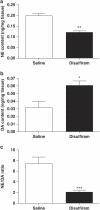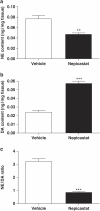Disulfiram attenuates drug-primed reinstatement of cocaine seeking via inhibition of dopamine β-hydroxylase
- PMID: 20736996
- PMCID: PMC2956132
- DOI: 10.1038/npp.2010.127
Disulfiram attenuates drug-primed reinstatement of cocaine seeking via inhibition of dopamine β-hydroxylase
Abstract
The antialcoholism medication disulfiram (Antabuse) inhibits aldehyde dehydrogenase (ALDH), which results in the accumulation of acetaldehyde upon ethanol ingestion and produces the aversive 'Antabuse reaction' that deters alcohol consumption. Disulfiram has also been shown to deter cocaine use, even in the absence of an interaction with alcohol, indicating the existence of an ALDH-independent therapeutic mechanism. We hypothesized that disulfiram's inhibition of dopamine β-hydroxylase (DBH), the catecholamine biosynthetic enzyme that converts dopamine (DA) to norepinephrine (NE) in noradrenergic neurons, underlies the drug's ability to treat cocaine dependence. We tested the effects of disulfiram on cocaine and food self-administration behavior and drug-primed reinstatement of cocaine seeking in rats. We then compared the effects of disulfiram with those of the selective DBH inhibitor, nepicastat. Disulfiram, at a dose (100 mg/kg, i.p.) that reduced brain NE by ∼40%, did not alter the response for food or cocaine on a fixed ratio 1 schedule, whereas it completely blocked cocaine-primed (10 mg/kg, i.p.) reinstatement of drug seeking following extinction. A lower dose of disulfiram (10 mg/kg) that did not reduce NE had no effect on cocaine-primed reinstatement. Nepicastat recapitulated the behavioral effects of disulfiram (100 mg/kg) at a dose (50 mg/kg, i.p.) that produced a similar reduction in brain NE. Food-primed reinstatement of food seeking was not impaired by DBH inhibition. Our results suggest that disulfiram's efficacy in the treatment of cocaine addiction is associated with the inhibition of DBH and interference with the ability of environmental stimuli to trigger relapse.
Figures








Similar articles
-
Effects of pharmacologic dopamine β-hydroxylase inhibition on cocaine-induced reinstatement and dopamine neurochemistry in squirrel monkeys.J Pharmacol Exp Ther. 2014 Jul;350(1):144-52. doi: 10.1124/jpet.113.212357. Epub 2014 May 9. J Pharmacol Exp Ther. 2014. PMID: 24817036 Free PMC article.
-
Elevated dopamine in the medial prefrontal cortex suppresses cocaine seeking via D1 receptor overstimulation.Addict Biol. 2016 Jan;21(1):61-71. doi: 10.1111/adb.12178. Epub 2014 Aug 19. Addict Biol. 2016. PMID: 25135633
-
Chronic inhibition of dopamine β-hydroxylase facilitates behavioral responses to cocaine in mice.PLoS One. 2012;7(11):e50583. doi: 10.1371/journal.pone.0050583. Epub 2012 Nov 27. PLoS One. 2012. PMID: 23209785 Free PMC article.
-
mechanisms of disulfiram-induced cocaine abstinence: antabuse and cocaine relapse.Mol Interv. 2009 Aug;9(4):175-87. doi: 10.1124/mi.9.4.6. Mol Interv. 2009. PMID: 19720750 Free PMC article. Review.
-
Disulfiram: an old therapeutic with new applications.CNS Neurol Disord Drug Targets. 2010 Mar;9(1):5-12. doi: 10.2174/187152710790966678. CNS Neurol Disord Drug Targets. 2010. PMID: 20201810 Review.
Cited by
-
Efficacy of disulfiram and Twelve Step Facilitation in cocaine-dependent individuals maintained on methadone: a randomized placebo-controlled trial.Drug Alcohol Depend. 2012 Nov 1;126(1-2):224-31. doi: 10.1016/j.drugalcdep.2012.05.019. Epub 2012 Jun 12. Drug Alcohol Depend. 2012. PMID: 22695473 Free PMC article. Clinical Trial.
-
Diversity of small molecule HIV-1 latency reversing agents identified in low- and high-throughput small molecule screens.Med Res Rev. 2020 May;40(3):881-908. doi: 10.1002/med.21638. Epub 2019 Oct 13. Med Res Rev. 2020. PMID: 31608481 Free PMC article. Review.
-
Chronic administration of a norepinephrine antagonist prevents and partially reverses escalation of cocaine self-administration.Addict Biol. 2023 Sep;28(9):e13316. doi: 10.1111/adb.13316. Addict Biol. 2023. PMID: 37644893 Free PMC article.
-
Long-term γ-hydroxybutyric acid (GHB) and disulfiram combination therapy in GHB treatment-resistant chronic alcoholics.Int J Environ Res Public Health. 2011 Jul;8(7):2816-27. doi: 10.3390/ijerph8072816. Epub 2011 Jul 6. Int J Environ Res Public Health. 2011. PMID: 21845160 Free PMC article.
-
Exposure to disulfiram and incidence of parkinsonism.J Occup Med Toxicol. 2025 Mar 12;20(1):8. doi: 10.1186/s12995-025-00454-9. J Occup Med Toxicol. 2025. PMID: 40075434 Free PMC article.
References
-
- Bourdélat-Parks BN, Anderson GM, Donaldson ZR, Weiss JM, Bonsall RW, Emery MS, et al. Effects of dopamine beta-hydroxylase genotype and disulfiram inhibition on catecholamine homeostasis in mice. Psychopharmacology (Berl) 2005;183:72–80. - PubMed
-
- Brown ZJ, Tribe E, D'souza NA, Erb S. Interaction between noradrenaline and corticotrophin-releasing factor in the reinstatement of cocaine seeking in the rat. Psychopharmacology (Berl) 2009;203:121–130. - PubMed
-
- Carroll KM, Nich C, Ball SA, McCance E, Frankforter TL, Rounsaville BJ. One-year follow-up of disulfiram and psychotherapy for cocaine-alcohol users: sustained effects of treatment. Addiction. 2000;95:1335–1349. - PubMed
Publication types
MeSH terms
Substances
Grants and funding
- R01 EY004864/EY/NEI NIH HHS/United States
- P30 EY006360/EY/NEI NIH HHS/United States
- DA027535/DA/NIDA NIH HHS/United States
- R01 DA017963/DA/NIDA NIH HHS/United States
- F31 DA019746/DA/NIDA NIH HHS/United States
- DA25040/DA/NIDA NIH HHS/United States
- T32 DA015040/DA/NIDA NIH HHS/United States
- R01 DA027535/DA/NIDA NIH HHS/United States
- F31 DA033091/DA/NIDA NIH HHS/United States
- DA015040/DA/NIDA NIH HHS/United States
- P30 EY06360/EY/NEI NIH HHS/United States
- EY004864/EY/NEI NIH HHS/United States
- F31 DA025040/DA/NIDA NIH HHS/United States
- DA017963/DA/NIDA NIH HHS/United States
- DA019746/DA/NIDA NIH HHS/United States
LinkOut - more resources
Full Text Sources
Other Literature Sources
Miscellaneous

